Round The World and other travels
A frequent flyer's collection of trip diaries
This is: A Taste of the Deep South (2013)
Beautiful Beaufort
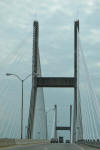 |
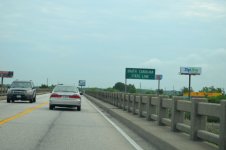 |
Breakfast was nice and quiet once again on this weekday morning. Although we had planned for a fairly early start, there was no particular pressure; the total journey for the day was one of only a little over 130 miles.
Around 9am, half an hour later than planned, we checked out, loaded up the car and hit the road. It was time to cross the Talmadge Memorial Bridge, leave the Peach State behind and head into what was for me the second new state of the trip.
| SOUTH CAROLINA | |
 |
SOUTH CAROLINA, the Palmetto State, entered the Union as the 8th state on 23 May 1788. It is the only state with an official state amphibian, the spotted salamander. At 60 miles, the Grand Strand is one of the longest beaches in the world, and the town of Ballentine on Lake Murray shares not only a Caledonian name, but also a mystery along the lines of Loch Ness with “documented sightings” of a creature that looks “like a cross between a snake and something prehistoric.” The Civil War famously started at Fort Sumter just off Charleston, where they put on a grand celebration to watch the proceedings unfold, wrongly assuming that it would all be short-lived and that the Confederacy would remain independent. The gaiety diminished rapidly as Charleston then endured a siege of more than 500 days, one of the longest of the Civil War. |
 |
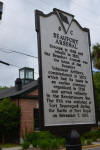 |
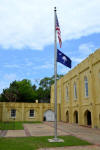 |
 |
First stop was to be the idyllic town of Beaufort. They pronounce it BEW-fort in these parts, which won't seem nearly so strange once you've had a second look at this page's title. About an hour north of Savannah, the town has been home to many a movie set because of its well-preserved stately homes surrounded by oak trees draped with Spanish moss – basically the picture we have in our minds of a languid Southern town. We parked the car at the Henry C Chambers Waterfront Park and walked the short distance to the Beaufort Arsenal (1852), nowadays home to the Visitor Center. The assistant there was incredibly friendly and helpful: after giving us lots of advice on what to see and where to see it, she surprised us by producing taster samples of the local specialty, she-crab soup. It was a delicious little mid-morning snack and I was once again left marvelling at the friendliness of people in this part of the USA.
We walked for a while in the area across Highway 21 known as The Old Point, which was where many of the most beautiful houses were to be found.
 |
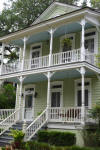 |
 |
 |
 |
 |
 |
 |
 |
 |
 |
We then looped back to the car via the town's traditional shopping area and the historically significant St. Helena’s Episcopal Church.
 |
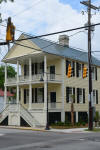 |
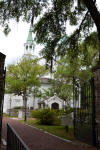 |
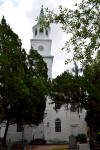 |
 |
||
 |
 |
 |
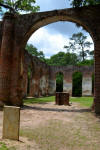 |
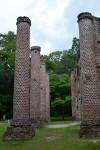 |
 |
 |
||
| ABOVE: The wonderfully atmospheric ruins of Old Sheldon Church | |||
We took to the road once more and after an abortive short diversion to nearby Port Royal - the guidebook recommended it, but we found nothing of interest there - we took Highway US21 towards Yemassee and stopped at the Old Sheldon Church ruins, dating from 1757. Bruce's guidebook described them as 'poignantly desolate' and also spoke of the 'serene, oak-lined grounds'. Having visited the site for myself, I fully endorse both descriptions. The original church had been one of the first Greek Revival structures in the United States, until the British burned it down in 1779. The new structure survived until 1865 when it is widely believed to have been razed again by General Sherman and the Union troops, although the information sign by the entrance (see photos) gives a somewhat different version of events.
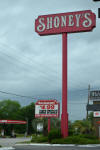
By this stage, time was getting on and I was really starting to feel the need of some lunch. We had already abandoned our planned venue - for the third day running! - when we decided not to stop in Port Royal. The only feasible option was to pull in at a fast food outlet at the first opportunity, which in practice meant a Shoney's burger joint at the next major highway intersection. It was a classic American diner and I enjoyed a really nice burger. Bruce informed me that we was experiencing a flashback to his teenage years!
 Our
personal fuel supplies duly replenished, we drove the remaining 40
miles to our next accommodation, The Inn at Middleton Place, which
had been a late addition to the plan prior to the start of the trip.
Middleton Place is one of a number of former plantations around 15
miles from downtown Charleston on the Ashley River Road. We had
always intended to visit it, along with neighbouring Drayton Hall.
Once we realised that the on-site accommodation at Middleton Place
included the otherwise expensive entry fee to the museum and
grounds, it became something of a no-brainer.
Our
personal fuel supplies duly replenished, we drove the remaining 40
miles to our next accommodation, The Inn at Middleton Place, which
had been a late addition to the plan prior to the start of the trip.
Middleton Place is one of a number of former plantations around 15
miles from downtown Charleston on the Ashley River Road. We had
always intended to visit it, along with neighbouring Drayton Hall.
Once we realised that the on-site accommodation at Middleton Place
included the otherwise expensive entry fee to the museum and
grounds, it became something of a no-brainer.
As our room wasn't yet ready on arrival, we
parked the car in a suitable spot and walked through the extensive
grounds to take the 4pm tour of the House Museum. While this was
interesting, we both felt that it simply hadn't been brought to life
in the manner of the excellent tour of the Owens-Thomas House that
we had taken in Savannah just the previous day. Once back in the
sunshine, we spent some more time enjoying the well-manicured,
formal gardens. I had been in plenty of similar examples
over the years, but never one that featured free-roaming alligators!
The specimens that were out of the water looked quite young, to be fair, but the
general opinion was that they would still be perfectly capable of
doing serious damage to the human body. ![]() I wondered what the Health & Safety people would have to say
back in the UK, and why they weren't saying it here, in the land of
litigation!
I wondered what the Health & Safety people would have to say
back in the UK, and why they weren't saying it here, in the land of
litigation!
 |
 |
 |
 |
 |
 |
 |
 |
 |
We eventually made our way back to the car,
picked up our key from the gatehouse, got settled into the room and
headed out again for the Manager's Reception, which was basically
the equivalent of cocktail hour in a hotel with an Executive Lounge.
We then walked to the restaurant through the luxuriant grounds. The
views were stunning, with some mirror-like reflections in the small
lake as daylight faded - trust me not to have my camera with me!
![]()
Dinner was pleasant enough, though not
spectacular. For a restaurant that appeared to have fine-dining
aspirations, the portions were quite ridiculously large. We walked
back to the hotel blocks to the accompaniment of a resonating
night-time chorus of crickets and frogs, trying hard to convince
ourselves with each gingerly placed footstep that it was now too
cool for snakes and alligators to be about.
![]()
![]()
![]()